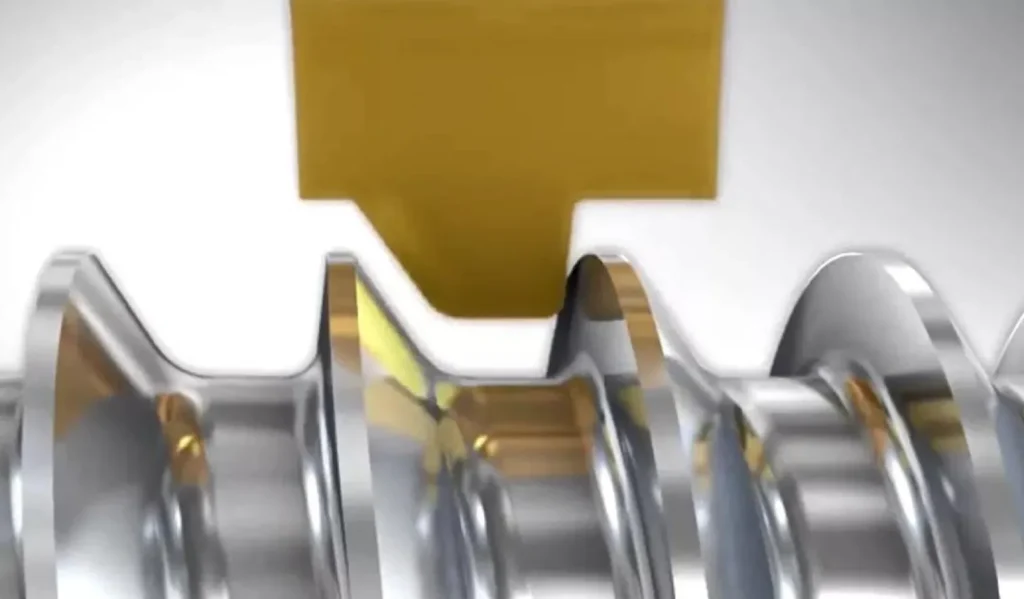在加工和金屬加工的世界中,選擇正確的切割工具材料對於實現最佳性能,效率和成本效益至關重要。該綜合指南探討了Cermet插入物,碳化物,立方硼(CBN)和多晶鑽石(PCD)切割工具之間的關鍵差異。通過了解每種材料的獨特屬性,應用程序和成本注意事項,您將有能力為您的加工需求做出明智的決定。

1。簡介:材料科學的最前沿
在切割工具材料方面,CERMET插入與CARBIDE與CBN與PCD的比較對於任何機械師或製造專業人員都是必不可少的。這些材料中的每一種都提供了不同的優勢和局限性,使其適用於不同的應用和工件材料。在本文中,我們將深入研究這些切割工具材料的複雜性,以幫助您自信地瀏覽複雜的加工世界。
2. cermet插入:兩全其美
組成和特性
Cermet Inserts,Portmanteau “陶瓷製品” 和 “金屬,” 將陶瓷材料的硬度與金屬粘合劑的韌性結合在一起。 Cermet Inserts通常由碳化鈦(TIC)或鈦碳耐鈦(TICN)顆粒組成,Cermet插入物提供了獨特的特性平衡。
優點和缺點
優點:
- 比碳化物更高的耐磨性
- 出色的熱穩定性
- 優越的表面飾面能力
- 良好的化學穩定性
缺點:
- 與碳化物相比,韌性較低
- 比碳化物插入物更脆
- 與碳化物相比有限
應用領域
Cermet插入Excel:
- 在鋼和鑄鐵上完成操作
- 較軟材料的高速加工
- 需要出色表面表面處理的應用
3。碳化物插入物:多功能主力
組成和特性
硬質合金插入,也稱為碳化物碳化物,由碳化鎢(WC)顆粒組成,該顆粒與鈷基質鍵合。該組成產生了一種將硬度與韌性結合在一起的材料,使其適用於廣泛的加工應用。
優點和缺點
優點:
- 良好的硬度和韌性平衡
- 可用於不同應用的廣泛等級
- 良好的耐磨性
- 許多加工操作的成本效益
缺點:
- 與陶瓷和超級材料相比,較低的熱硬度
- 可能需要塗層以提高某些應用中的性能
應用領域
碳化物插入物被廣泛使用:
- 各種材料的通用加工
- 銑削,轉彎和鑽孔操作
- 粗糙和半固定操作
4。立方硼硝酸鹽(CBN):鋼鐵專家
組成和特性
立方硼(CBN)是一種合成的超級智能材料,僅在硬度中僅次於鑽石。它是通過將六角硼硝化物施加到高溫和壓力的情況下而產生的,從而產生了立方晶體結構。
優點和缺點
優點:
- 極端硬度和耐磨性
- 出色的熱穩定性
- 加工硬化鋼的卓越性能
- 加工亞鐵材料時的化學穩定性
缺點:
- 與碳化物和Cermet相比,成本更高
- 脆性的自然需要仔細的處理和應用
- 對較軟材料的有效性有限
應用領域
CBN擅長:
- Machining hardened steels (>45 HRC)
- 鑄鐵的高速加工
- 完成操作需要緊張的公差
CBN與PCBN
多晶立方硼硝酸鹽(PCBN)是CBN的變體,其中CBN顆粒用陶瓷或金屬粘合劑燒結。與純CBN相比,PCBN提供了改善的韌性,使其適合中斷的切割操作和更多樣化的應用。
5。多晶鑽石(PCD):非有產專家
組成和特性
多晶鑽石(PCD)由鑽石顆粒與金屬粘合劑(通常是鈷)組成。這導致具有出色硬度和耐磨性的材料。
優點和缺點
優點:
- 無與倫比的硬度和耐磨性
- 出色的導熱率
- 優越的表面飾面能力
- 適當應用中的長工具壽命
缺點:
- 高成本
- 在高溫下用鐵質材料的化學反應性
- 脆性的自然需要仔細的處理和應用
應用領域
PCD切割工具是:
- 加工非金屬(鋁,銅,黃銅)
- 切割磨料材料(玻璃纖維,碳纖維複合材料)
- 超精確加工操作
6。比較分析:cermet插入vs碳化物與CBN與PCD
硬度比較
在比較CERMET插入與CARBIDE與CBN與PCD時,硬度是關鍵因素。從最柔軟到最難:
- 碳化物
- Cermet
- CBN
- PCD
重要的是要注意,雖然PCD是最困難的,但由於其限制了鐵質材料,它並不總是最佳的選擇。
成本比較
這些切割工具材料的成本差異很大。從最便宜到最昂貴的:
- 碳化物
- Cermet
- CBN
- PCD
CBN和PCD的成本較高,通常可以通過其出色的性能和在適當應用中使用更長的工具壽命來證明。
在不同應用中的性能
- CERMET插入物:最適合在鋼和鑄鐵上完成操作,提供出色的表面飾面。
- 碳化物:多功能性能,適合多種材料和操作。
- CBN:擅長加工硬化的鋼並鑄造熨斗,尤其是在高速下。
- PCD:無色和磨料材料中無與倫比的性能。
7。經常問的問題
CBN比碳化物難嗎?
是的,CBN比碳化物要硬。在knoop硬度量表上,CBN通常為4000至5000 khn,而碳化物的範圍為1000至2000 khn。
CBN插入物是用什麼?
CBN插入物主要用於加工硬化鋼(>45 hrc),鑄鐵和其他硬材料。他們在高速加工和精加工中表現出色,需要緊張的公差。
CBN車輪會銳化碳化物嗎?
是的,CBN車輪可以有效地培養碳化物工具。 CBN的極端硬度使其適合磨削和銳化碳化物切割工具,提供精確耐用的邊緣。
PCD和CBN有什麼區別?
PCD和CBN之間的主要區別是:
- 硬度:PCD比CBN更難
- 化學穩定性:加工亞鐵材料時,CBN更穩定
- 應用:PCD在非有效性和磨料的材料中表現出色,而CBN則更好地適合硬化鋼和鑄鐵
為什麼CBN比PCD更好?
CBN由於高溫下的化學穩定性而更適合加工鋼。 PCD傾向於在高溫下與鐵反應,從而導致快速的工具磨損。 CBN保持穩定,可以有效地加工硬化的鋼並鑄造鐵。
CBN比鑽石難嗎?
不,CBN並不比鑽石更難。鑽石(包括PCD)是最難的已知天然材料。但是,CBN是第二高的材料,在某些應用中,尤其是在加工亞鐵材料時,它比鑽石具有優勢。
為什麼CBN如此昂貴?
CBN由於幾個因素而昂貴:
- 複雜的製造過程涉及高溫和壓力
- 自然發生有限,需要合成生產
- 生產所需的專業設備和專業知識
- 由於其獨特的特性,工業應用的需求量很高
8。詳細的組成和理化特徵
在比較CERMET插入碳化物與CBN與PCD時,重要的是要了解每種材料的詳細組成和物理化學特徵。這些知識為他們在各種加工應用中的性能提供了深入的了解。
8.1 cermet
作品:
- 硬相:通常按體積為70-85%,由碳化鈦(TIC),氯化鈦(TICN)或硝酸鈦(TIN)組成
- 粘合劑階段:通常按體積為15-30%,由鎳,鉬和/或鈷組成
物理化學特徵:
- 密度:5.6-7.4 g/cm³,具體取決於成分
- 硬度:1500-2200 HV(Vickers Hartness)
- 導熱率:15-40 W/m·K
- 熱膨脹係數:7.0-8.5×10⁻⁶/k
- 橫向破裂強度:1200-2500 MPA
- Young的模量:400-450 GPA
Cermet將陶瓷的高硬度與金屬的韌性結合在一起,提供出色的耐磨性和熱穩定性。基於鈦的硬相具有硬度和耐磨性,而金屬粘合劑則增強了韌性和熱衝擊性。
8.2碳化物
作品:
- 硬階段:通常按體積為70-97%,由碳化鎢(WC)組成
- 粘合劑階段:通常按體積為3-30%,主要是鈷(CO)
物理化學特徵:
- 密度:11.0-15.0 g/cm³,具體取決於鈷含量
- 硬度:1000-1800 HV,與鈷含量成反比
- 導熱率:50-100 W/m·K
- 熱膨脹係數:4.9-7.1×10⁻⁶/k
- 橫向破裂強度:1500-3000 MPA
- Young的模量:450-650 GPA
碳化物插入物在硬度和韌性之間提供平衡。碳化鎢具有耐磨性和硬度,而鈷粘合劑則增強了韌性和抗衝擊力。可以通過改變碳化物晶粒尺寸和鈷含量來調整這些性能。
8.3立方硼硝酸鹽(CBN)
作品:
- CBN晶體:50-95%的體積
- 粘合劑階段:5-50%按體積為5-50%,通常為陶瓷(例如,錫,Aln)或金屬(例如Co,Co,Ni,Al)
物理化學特徵:
- 密度:3.4-4.3 g/cm³
- 硬度:4000-5500 HV
- 導熱率:100-200 W/m·K
- 熱膨脹係數:4.6-4.9×10⁻⁶/k
- 橫向破裂強度:500-800 MPA
- Young的模量:680-720 GPA
CBN是一種合成的超胸材料,具有類似於鑽石的立方晶體結構。它提供了出色的硬度,熱穩定性和化學惰性,尤其是在加工亞鐵材料時。高導熱率可在加工過程中有效地耗散熱量。
8.4多晶鑽石(PCD)
作品:
- 鑽石晶體:90-95%的體積
- 粘合劑階段:5-10%按體積,通常為鈷
物理化學特徵:
- 密度:3.5-4.0 g/cm³
- 硬度:8000-10000 HV
- 導熱率:500-2000 W/m·K
- 熱膨脹係數:2.0-4.8×10⁻⁶/k
- 橫向破裂強度:1200-1700 MPA
- Young的模量:776-925 GPA
PCD由鑽石顆粒與金屬粘合劑(通常是鈷)組成。它具有無與倫比的硬度和耐磨性,並結合出色的導熱率。然而,PCD在高溫下用鐵化學反應性,從而限制了其在加工鐵質材料中的使用。
物理化學特性的比較分析
當評估CERMET插入vs Carbide vs CBN與PCD時,幾種關鍵的物理化學特性脫穎而出:
- Hardness: PCD > CBN > Cermet > Carbide This hierarchy directly influences wear resistance and tool life in abrasive applications.
- Thermal Conductivity: PCD > CBN > Carbide > Cermet Higher thermal conductivity allows for better heat dissipation during machining, potentially enabling higher cutting speeds.
- Density: Carbide > Cermet > PCD > CBN Lower density materials like CBN and PCD can be advantageous in high-speed rotating tools, reducing centrifugal forces.
- Thermal Expansion: Cermet > Carbide > CBN > PCD Materials with lower thermal expansion coefficients maintain better dimensional stability during temperature fluctuations in machining processes.
- Transverse Rupture Strength: Carbide > Cermet > PCD > CBN Higher transverse rupture strength indicates better resistance to chipping and fracture, particularly important in interrupted cutting operations.
在為特定加工應用選擇最佳切割工具材料時,了解這些詳細的組成和理化特徵至關重要。 CERMET插入與CARBIDE與CBN與PCD之間的選擇應基於對工件材料,加工參數和所需結果的仔細考慮。
9.結論:選擇正確的切割工具材料
在CERMET插入與CABIDE與CBN與PCD的辯論中,沒有一定大小的解決方案。選擇取決於各種因素,包括:
- 工件材料
- 加工操作(粗糙,精加工,高速加工)
- 所需的表面飾面
- 工具壽命的期望
- 預算限制
通過了解每種材料的獨特屬性,優勢和局限性,您可以做出明智的決定以優化加工過程。請記住,儘管CBN和PCD等高級材料在特定應用中提供了卓越的性能,但諸如Carbide和Cermet Inserts之類的傳統選擇仍然在現代加工操作中佔有一席之地。
隨著加工技術的不斷發展,了解切割工具材料的信息將幫助您保持行業的競爭優勢。無論您是使用普通鋼還是異國合金,都有一種適合您需求的切割工具材料。


